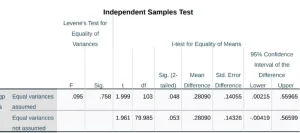RSCH FPX 7864 Assessment 3 ANOVA Application and Interpretation RSCH-FPX 7864 Quantitative Design and Analysis
Prof. Name:
Date
ANOVA Application and Interpretation
The independent t-test investigates the association between gender (independent variable) and GPA (dependent variable). Gender is categorical, while GPA is continuous. The research inquiry delves into the influence of gender on GPA levels. The null hypothesis posits that gender has no impact on GPA levels, while the alternative hypothesis suggests that gender does affect GPA. The assumptions for the test are outlined in Table 1.
Table 1. Independent Samples Test
Levene’s Test for Equality of Variances

Levene’s test assesses the homogeneity of variances between GPA (dependent variable) and gender (independent variable). A significance level below .05 indicates significantly distinct variances. In this investigation, Table 1 data reveals a significance level of .758, implying no substantial difference between the two variables. Assumptions of equal variances are upheld, signifying homogeneity.
Results and Interpretation
Table 2. Group Statistics

Group statistics in Table 2 present the mean GPA for females (n=64) at 2.97 with a standard deviation of 0.678 and for males (n=41) at 2.69 with a standard deviation of 0.739. Despite assuming equal variances, the homogeneity assumption is not met. The Levene’s test significance value of .048 indicates slightly different variances. However, since .048 < .05, the null hypothesis is not rejected, and the groups’ variability is not significantly different.
Statistical Conclusions
This study explores GPA differences among genders using an equal variance t-test, revealing a statistically significant difference in GPA means for males and females (Males: M = 2.69, SD = 0.74; Females: M = 2.97, SD = 0.68, p = .758 > .05). Limitations include assumptions associated with the t-test and unequal sample sizes. Future studies could delve into support networks for achieving higher GPAs.
Application
Proficient HR leaders can utilize trend analysis tools, such as time and attendance, to identify factors influencing staff outcomes. For instance, staffing initiatives and safety training effectiveness can be evaluated. Continuous analysis aids in recognizing factors impacting workplace activities and employee outcomes.
References
Field, A. (2018). Discovering Statistics Using IBM SPSS Statistics. SAGE Publications.
RSCH FPX 7864 Assessment 3 ANOVA Application and Interpretation
Levene, H. (1960). In Contributions to Probability and Statistics: Essays in Honor of Harold Hotelling, I. Olkin et al. (eds.), Stanford University Press, pp. 278-292.